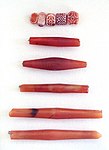Etched carnelian beads
Etched carnelian beads, or sometimes Bleached carnelian beads, are a type of ancient decorative beads made from carnelian with an etched design in white, which were probably manufactured by the Indus Valley civilization during the 3rd millennium BCE. They were made according to a technique of alkaline-etching developed by the Harappans, and vast quantities of these beads were found in the archaeological sites of the Indus Valley civilization.[2][1][3][4] They are considered as an important marker of ancient trade between the Indus Valley, Mesopotamia and even Ancient Egypt, as these precious and unique manufactured items circulated in great numbers between these geographical areas during the 3rd millennium BCE, and have been found in numerous tomb deposits.[5]
Production technique[]
(3rd millennium BCE)
Etched carnelian beads with characteristic designs are widely known from various Indus Valley civilization sites dating to the 3rd millennium BCE, such as at Dholavira, and these beads "were exported to the Mesopotamian region during second half of 3rd millennium BC and were of extreme importance".[8][9]
The technique used in making etched carnelian beads has been the object of ethnographical studies, particularly by H.C. Beck.[10][11] It is rather complex and relies on delicate craftsmanship, etching chemical reactions and proper firing.[10] First, the bead has to be shaped and polished from its raw state and pierced in its center, in order to form a regular bead of the desired shape.[5] This process alone can take three to eight days of work.[5]
Then a chemical etching agent has to be formulated, which is typically a sticky paste formulated from an alkaline washing soda solution (Sodium carbonate) and plant juice, most commonly Capparis aphylla, a bush growing in dry or arid areas in Africa, Iran, Pakistan and India.[10] Once mixed, the texture of the paste also has to be just right to allow for a good spread without bleeding, thus permitting the creation of a beautiful design.[10] The paste, once applied, is left to dry, at which point it only forms a transparent varnish.[10][5]
The bead with its design than has to be fired at the proper temperature, not too hot lest the beads fractures, but hot enough so as to permit the chemical etching of the carnelian stone.[10] The result design comes out beautifully white, usually with some surface calcinated residues which can be easily brushed away.[10][5]
In 1933, Ernest Mackay studied the process as still being implemented in Sindh,[12] which was summarized by Gregory Possehl in the following terms:
"The process began with the juice extracted from the tips of young shoots of a bush called 'kirar' in Sindhi (Capparis aphylla). The informant then ground washing soda to a fine powder and mixed it with water in a cup. He poured a small quantity of this on the kirar and rubbed the whole carefully together to a semfluid mass. Then the craftsman strained this mixture through a piece of linen into a large empty mussel shell, and the "paint" was ready. Ths paint was applied to a carnelian stone using a reed pen. The painted stone was then allowed to dry, first in the hand, then by placing it on a metal plate over a charcoal fire. When fully dry, the carnelian was covered with live coals and the fire fanned for about five minutes. The piece was then removed from the heat and allowed to cool slowly for about 10 minutes under an inverted cup, at which point the craftsman rubbed his piece of carnelian briskly with a rag and handed it over for inspection. It was perfect!"
— Gregory Possehl, The Indus Civilization: A Contemporary Perspective.[13]
Mesopotamia[]
Etched carnelian beads from the Indus were found in the tombs of the Royal Cemetery of Ur, dating to 2600–2450 BCE.[15] They are an important marker of Indus–Mesopotamia relations in ancient times. The Neo-Sumerian ruler Gudea (circa 2100 BCE), in his Gudea cylinders (cylinder B XIV), mentioned his procurement of "blocks of lapis lazuli and bright carnelian from Meluhha."[16][17] Meluhha is generally identified with the Indus region, and there are no known mentions of Meluhha after 1760 BCE.[18] It is thought that these carnelian beads were considered as an important status symbol in Sumerian society.[5]

Etched carnelian beads excavated in tomb PG 1133 of the Royal Cemetery of Ur, 2600-2500 BCE.[19]

Indus Valley Civilization carnelian beads excavated in Susa. Louvre Museum

Harappan carnelian beads, excavated in the Royal Cemetery at Ur. British Museum
Local Mesopotamian creations (Akkadian and Ur III periods, circa 2100 BCE)[]
(c. 2094–2047 BCE)












